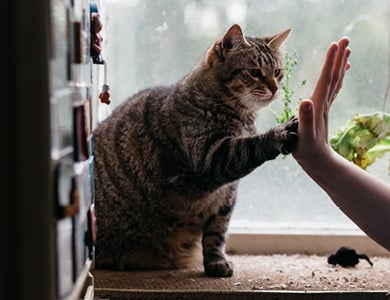Sit! High-five! Turn around! Many of thus think that only dogs can learn to do these kinds of tricks for us, but guess what? Cats can learn these tricks as well, and fairly easily!
For cats, learning tricks is a stimulating and even pleasant activity, allowing them to expend energy in a different way in the same amount of time it takes to play a game. Plus, it keeps them from tearing up the blinds!
In fact, once they’ve gotten the hang of commands, you’ll realize that the distance between “High-five!” and “Gimme your paw!” or even “Let’s cut your nails!” isn’t so vast at all.
There are a number of techniques for training cats to do tricks. One such technique involves using a clicker, but for now we’ll explain a simple method involving no objects whatsoever that can be easily practiced at home.
 Teach with positive reinforcement
Teach with positive reinforcement
First of all, it’s important to remember that reprimanding your cat in even the slightest way (i.e., a simple “no”) will automatically demotivate them. By the same token, no expression of frustration on your part will be well received by your cat.
“So,” you’re probably asking, “how do I motivate my cat?”
The simple answer? Treats! Assuming your cat doesn’t have any dietary restrictions, the first thing to do is find a treat so irresistibly delicious your cat will do anything to get one! For cats with refined taste, their daily diet can even serve as a treat.
Sometimes it takes a while to find that perfect treat. Beef-, chicken- or malt-flavoured toothpaste for cats is excellent for training. Remember that, to them, half a treat is as good as a whole treat! So, cut the treat into two or four pieces — you’ll help maintain their weight while providing motivation!
Also, note that, in general, cats don’t stay motivated long. Three short five-minute sessions throughout the day are better than one long 15-minute session. The environment must be calm and clear of distractions such as children, other animals, or TV. The bathroom will often suffice for training purposes.
Teaching the high-five: Four easy steps
Step1
Grab a treat and place it between two of your fingers inside your open palm.
Step 2
Place your hand above the cat’s head as if you want them to give you a high-five. As soon as they touch your hand with their paw, give them a little “congrats!” and hand them a treat.
If they try to get on their hind legs to take the treat with their teeth or front paws, lift your hand away from their face to force them to use their paw.
Try not to be too demanding at first. If they touch your hand with their paw, regardless of where on the hand, give them the treat. If they don’t reach their paw out all the way at first, reward them simply for reaching out their paw. As they continue to learn over time, you can challenge them a bit by waiting for them to lift their paw higher until they touch the center of your palm.
Step 3
After a few training sessions, your cat should catch on and automatically raise their paw whenever you show them your palm. If this is the case, show them your palm, but without the treat. Your cat should give a high-five regardless, out of habit. If they do, say “congrats!” and reward them, but give them a treat with the other hand. As such, your cat will understand that it’s not the treat, but the high-five that brings the reward.
Step 4
Once your cat has understood the principle and can perform the trick easily, make a slight forward motion when their paw touches your palm to give them a real high-five, and say “high-five!” when you’re doing it. In doing so, you’re assigning a command word to the gesture. You can continue giving them a treat every second time, and then every third time, and so on. However, be sure to give them a treat at some point. Less motivated cats may need to be rewarded every single time.
Lastly, when beginning to train your cat, it’s important to be patient so as not to discourage them. View the activity as a motivating game between yourself and your cat. You won’t believe the surprise on guests’ faces when they see what your little kitty can do!







